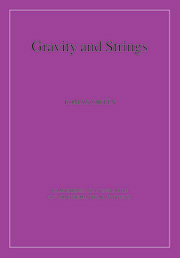Book contents
- Frontmatter
- Contents
- Preface
- Part I Introduction to gravity and supergravity
- Part II Gravitating point-particles
- 7 The Schwarzschild black hole
- 8 The Reissner–Nordström black hole
- 9 The Taub–NUT solution
- 10 Gravitational pp-waves
- 11 The Kaluza–Klein black hole
- 12 Dilaton and dilaton/axion black holes
- 13 Unbroken supersymmetry
- Part III Gravitating extended objects of string theory
- Appendix A Lie groups, symmetric spaces, and Yang–Mills fields
- Appendix B Gamma matrices and spinors
- Appendix C n-Spheres
- Appendix D Palatini's identity
- Appendix E Conformal rescalings
- Appendix F Connections and curvature components
- Appendix G The harmonic operator on ℝ3 × S1
- References
- Index
13 - Unbroken supersymmetry
Published online by Cambridge University Press: 20 February 2010
- Frontmatter
- Contents
- Preface
- Part I Introduction to gravity and supergravity
- Part II Gravitating point-particles
- 7 The Schwarzschild black hole
- 8 The Reissner–Nordström black hole
- 9 The Taub–NUT solution
- 10 Gravitational pp-waves
- 11 The Kaluza–Klein black hole
- 12 Dilaton and dilaton/axion black holes
- 13 Unbroken supersymmetry
- Part III Gravitating extended objects of string theory
- Appendix A Lie groups, symmetric spaces, and Yang–Mills fields
- Appendix B Gamma matrices and spinors
- Appendix C n-Spheres
- Appendix D Palatini's identity
- Appendix E Conformal rescalings
- Appendix F Connections and curvature components
- Appendix G The harmonic operator on ℝ3 × S1
- References
- Index
Summary
In our study of several solutions in the previous chapters we have mentioned that some special properties that arise for special values of the parameters (mass, charges) are related to supersymmetry; more precisely, to the existence of (unbroken) supersymmetry. Those statements were a bit surprising because we were dealing with solutions of purely bosonic theories (Einstein–Maxwell, Kaluza–Klein …).
The goal of this chapter is to explain the concept and implications of unbroken supersymmetry and how it can be applied in purely bosonic contexts, including pure GR. Supersymmetry will be shown to have a very deep meaning, underlying more familiar symmetries that can be constructed as squares of supersymmetries. At the very least, supersymmetry can be considered as an extremely useful tool that simplifies many calculations and demonstrations of very important results in GR that are related directly or indirectly to the positivity of energy (a manifest property of supersymmetric theories).
As a further reason to devote a full chapter to this topic, unbroken supersymmetry is a crucial ingredient in the stringy calculation of the BH entropy by the counting of microstates. It ensures the stability of the solution and the calculation under classical and quantum perturbations.
To place this subject in a wider context, we will start by giving in Section 13.1 a general definition of residual (unbroken) symmetry and we will relate it to the definition of a vacuum. Vacua are characterized by their symmetries, which determine the conserved charges of point-particles moving in them and, ultimately, the spectra of quantum-field theories (QFTs) defined on them.
- Type
- Chapter
- Information
- Gravity and Strings , pp. 369 - 402Publisher: Cambridge University PressPrint publication year: 2004

